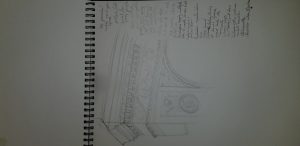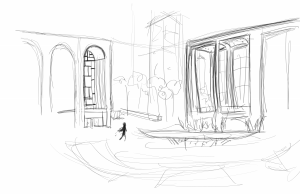Author: Julia (Page 1 of 2)
I think that this class has been one of the biggest benefits to me this semester. After three years I’ve been mad about not spending more class time outside, and signing up for this class I had no idea that this would even be an option. To be able to actually experience what we are learning about feels not only fun, but like I’m in a serious institute that cares about its student’s development. Sketching is another skill that I felt like I lacked, and 5 minute sketching was extremely beneficial. I have no complaints about the course itself, but rather the lack of storage and school facilities in general; even so, It wasnt an excuse for me not to show up to class. I looked forward to every Monday, and I truly wish for more students to be interested in real life education like this. If more classes could be taught like this, I would sign up for them all.
How does the MoMA garden relate to other spaces in the city? What makes it
special? How does the architecture relate to the space?
The MoMA garden seems to be a center of all amazing architecture in the city. Being a centroid of this modern architecture, it has a view of an art deco apartment; the Wardrobe building, also known as the AT&T building; and skyscrapers that gives you a full view of range of the neighborhood. What makes this area special is that it is alos a privately owned public space, that people are able to gather in and interact.
I think of the garden itself being architecturally significant; there is a reference to Le Corbusier at the buildings. Pilotis holding up a roof that saves you from the rain. The relief in the buildings is an emphasis that stands out to me, creating a more of a balance in the facades of the buildings that feels right. Not a balance of a scale, but just a balance of not wanting to change the current design.
Overall, the garden was aesthetically pleasing from the interior point of view of the MoMA. The floor to ceiling glass gives you the feeilng of being outdoors without being in the rain, the high ceilings make you forget one exists, the large flat plaza feels like it continues into the exterior, even though there is a material difference between the two.
What is important about the way civic infrastructure is developed in a city? How
do Penn Station and Grand Central reflect New York City’s civic architectural
culture and history?
Penn station has been in the history books, as it has helped to develop the Landmark Preservation Department through it’s demise. After the proposed demolition of Pennsylvania Station, many protests had gone on, and even that didnt stop the developers. It is one of the most important buildings in architectural history that no longer exists, and it made a massive impact on the entire country.
Grand Central Station has for sure benefited from the demise of Penn Station. It is a wonderful design for a train station, with higher and lower levels that guide people from the street level to the station levels, with sloping floors and stairs. It has a beautiful ceiling with the constellations painted on them, and lights shining through each one of the main stars.
Even though the both of these buildings were and are beautiful, i believe that the designs and building of the tracks and tunnels themselves would be more important than them; but the way that new york city was designed didnt help very much with infastructure in the city.
How do the Chrysler and Empire compare? Describe the massing, materials, and
detailing of each?
The Chrystler building is an eager representation of Art Deco Architecture. Standing on street level, and I, finally seeing the building not from miles away through other buildings, saw this grand entrance that guides you inside; the bright light from the interior softly glowing through the translucent panels that face the back on this coffin shaped archway. The intricate details stuck in my mind, ranging from the zigzag patterns to the simple pentagonal shapes of the glass in the entrance doors. The entire base floor is encased in a black stone that surprised me after only seeing the crown for so long.
In contrast, the Empire State Building seems much less decorative. A building that is now a tourists attraction, there is a possibility for that to be its goal in the first place. Being built in hopes to be the tallest building in the city, and having a blimp landing pad, it all seems like some sort of PR stunt. The building itself has extreme verticallity, as if guiding your eyes up towards the sky. Majority of it being steel and glass, i can see how it was modern during the initial building phase. It looks more like a stacked wedding cake than the Chrystler, with less circular details. The exterior facade is lined with limestone and granite, which is very pleaseing aesthetically
Compare place making and urban planning at Hudson Yards to Battery Park City.
Battery park city, was extended land that didn’t have a previous, or double use; it is extended land, off of the coast of manhattan, and was initially designed to be some sort of recreational space for the people living in the neighborhoods. The area includes parks, walkways by the coast of the Hudson river, a getty for recreational sailboats to park, and a connection to shopping centers.
Hudson yards was created as a benefit for the city on top of train yards; it is more seen, in my opinion, as upgrading the land, as well as upping its value. That could be looked at as a negative thing, that includes gentrification, but there could also be a positivity to this; for example, adaptive reuse. By reusing the highline, instead of demolishing land, it benefits the entire population of everyone, and not adding to the heaps of already existing pollution.
I do think, that because the Hudson yards are an after thought, that they aren’t as cohesive as they could be; its more of an advertisement and tourist entertainment.
What I did thing was interesting, is that both of there had some sort of raised pedestrian element to them; Battery park originally was supposed to be a raised pedestrian area that separated vehicular traffic from foot traffic; now, in a way, the Highline is an extension of that type of thinking, but developed from a pre-existing condition that was a train track and train yard.
Lincoln Center urban renewal seems like a force pushed down into a neighborhood, that causes a major displacement of the people – the poorer residents are just forced to move into neighborhoods already stuffed to the brim with these issues. Battery Park, in contrast, was developed from scratch; this design was worked on as the land on the coast of Manhattan was being filled to extend the land further. Though the original concept never came to fruition, as it was considered impractical, this placement rather than displacement is a much more soothing action. The design of battery park is integrated into the surroundings, extending the streets and avenues down into the park. Despite the fact that Lincoln Center is also inside of the grid of the city, I will not label it as integrated, as it had not taken into account the lots and the homes of the people living there already.
The current spatial experience of the Tower in the Park feels like a waste of space; that is, when focusing on the projects in new york city – the housing structure, vesus the surrounding greenspace – seems like there is no point to it in the first place. Greenspace should be use as leisure and play; but caging the grass presents a clear idea. I dont think this is a design option; this seems like a more political issue, rather than architecture. The urbanism of Battery Park seems more amusing; and the parks rolled out between apartment buildings are smaller, but more accessible. Creating extra park space right on the waterfront for anyone to access is very successful from my point of view.
Civic centers to be a focal point of a community, whether that is for sports, arts or performances. Lincoln center relates to the city around it by disassembling the previous lacking block, and force it to become a sophisticated neighborhood with a plaza that allows for people to see each other in bright spotlight, forcing a safety down onto the people.
Walking into the rainy plaza of Lincoln Center and being protected by the colonnades from the rain was slightly reassuring. This nucleus of the arts that it is, it seems like an elaborate expanse with these buildings towering over you, but also providing an unexpected shelter from the elements. A huge piece of land is surrounded on three sides by glass front buildings, inviting you in, with a fountain in the middle for aesthetics. This land used to be a neighborhood, an entire block with residences on it; after hearing the history behind it, the Center became slightly more concerning.
The idea of taking land from people because you don’t like the neighborhood and turning it into an open space just doesn’t sit right with me. I’m sure that there are better ways to implement the arts and safety into already existing neighborhoods. I know for a fact that actions like these will cause greater issues in surrounding areas, as this one improves. When it comes to residential buildings here, the ones we had looked like weren’t exactly too practical; I understand wanting to use the idea of the tower and the land of Le Corbusier, but the implementation doesn’t look that great now. The idea of having your own little suburbia in the middle of the city seems a little bit unrealistic; most importantly, having a street terminate into a parking lot also makes the area feel unsafe, as there isn’t any storefronts or anyone who is surveilling. The parking lots that could instead be parks seemed more and more intimidating as the night drew close, and having only one exit way seems downright dangerous.
From the National Museum of the American Indian you can see a clear path of how the city was designed; a straight line of view that follows Broadway. The buildings seem like they stand back to show this view, and creating this perfect square – or, rather triangle- that is a great gathering space for the people. Being that this important structure stood as the Customs House decades ago, it stands at a prime location that was easily accessed from the ships that docked lower Manhattan. This path from the water to the house would eventually become the official road that exists today. Over the years, these landmarks stood as a pin in the master plan of Manhattan, forcing everything around them to adapt to them. Roads that weren’t there before are created, and forced to terminate at the lot of the landmarks. Trinity church, for example, is crowded by more modern and taller buildings that were obviously not there at the time of design; but thanks to the street layout, the church is framed by these two buildings, a street guiding you perfectly to it. Although it is physically dark, made of brown stone, it seems like a much more holy place with its, and the streets, placement.
Finally, the Brooklyn Bridge also had a line of sight that is followed by a street, and not to mention it has an amazing view from atop it. The fact that the way they tested it was by walking elephants across it is a fun fact that will always be stuck in my head.





Recent Comments